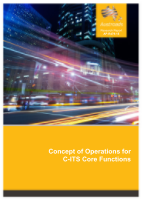Connected and Automated Vehicles

Concept of Operations for C-ITS Core Functions
- Publication no: AP-R479-15
- ISBN: 978-1-925294-13-2
- Published: 18 March 2015
- PDF (free) Download
This document defines the core functions of the C-ITS platform including their objectives and capabilities. It identifies user needs and describes how the system will operate.
The Concept of Operations is intended to be an input to future decision making and system engineering documents, including system requirements and design documentation.
- Preface
- 1. Scope
- 1.1. Identification
- 1.2. Document Overview
- 1.2.1. Purpose
- 1.2.2. Methodology
- 1.2.3. Structure of the Document
- 1.3. System Overview
- 1.3.1. Cooperative Intelligent Transport Systems
- 1.3.2. System of Systems
- 1.3.3. C-ITS Core Functions
- 1.3.4. Roles and Stakeholders
- 2. References
- Standards
- 3. Current Situation
- 3.1. Background
- 3.2. Policies
- 3.3. Description of the Current Situation
- 3.3.1. ITS in Australia and New Zealand
- 3.3.2. National ITS Architecture for Australia and New Zealand
- 3.3.3. Vehicle Telematics Services
- 3.3.4. Wireless Communication Technologies
- 3.3.5. Positioning Services
- 3.3.6. International Developments
- 4. Justification for and Nature of Changes
- 4.1. Justification for Changes
- 4.1.1. Vision, Drivers and Objectives
- 4.1.2. Limitations of the Current Situation
- 4.1.3. Need for Core Functions
- 4.2. Description of the Desired Changes
- 4.3. Priorities Among Changes
- 4.4. Changes Considered but not Included
- 4.5. Constraints and Assumptions
- 4.5.1. Constraints
- 4.5.2. Assumptions
- 5. Concepts for the Proposed System
- 5.1. Background, Objectives and Scope
- 5.1.1. Background
- 5.1.1. Objectives
- 5.1.2. Scope
- 5.2. Operational Policies and Constraints
- 5.3. Description of Proposed System
- 5.3.1. Secure Exchange of Data Between Users and Applications
- 5.3.2. Support Trust in and Integrity of Data
- 5.3.3. Assurance of Privacy
- 5.3.4. Facilitate a Platform for Sharing of Information and Efficient Use of Resources
- 5.3.5. National Interoperability and Consistency
- 5.3.6. Functional Subsystems
- 5.3.7. Core Data
- 5.4. Modes of Operation
- 5.5. Organisational Structure
- 5.6. Support Environment
- ITS
- ICT
- Vehicles
- Standards/general
- 6. Operational Scenarios
- 6.1. Communication Scenarios
- 6.2. Vehicle-originated Broadcast
- 6.3. Infrastructure-originated Broadcast
- 6.4. Infrastructure-vehicle-unicast
- 6.5. Local (Non-) Time-critical Sessions
- 6.6. Multi-roadside Unit Sessions
- 7. Summary of Impacts
- 7.1. Operational Impacts
- 7.2. Organisational Impacts
- 7.3. Impacts During Development
- Policy
- System management
- System operation
- Users
- Policy
- System Management
- System Operation
- Users
- Policy
- System management
- System operation
- Users
- 8. Analysis of the Proposed System
- 8.1. Summary of Improvements
- 8.2. Disadvantages and Limitations
- 8.3. Alternatives and Trade-offs Considered
- 8.3.1. Alternatives
- 8.3.2. Trade-offs
- Policy
- System management
- System operation
- Users
- Policy
- System management
- System operation
- Users
- Appendix A Stakeholder Consultation
- A.1 Key Findings
- A.1.1 Role
- A.1.2 Certification
- A.1.3 Data
- A.1.4 Scenarios
- A.1.5 Application
- A.1.6 Communication
- A.1.7 Core
- A.2 Method
- A.3 Questionnaires
- A.3.1 Questions (User Layer)
- Appendix B Core Needs
- B.1 Overview of Core Needs and Priorities
- B.2 Description of Core Needs
- B.3 Australian and New Zealand Rationale for Core Needs
- Appendix C C-ITS Applications and Use Cases
- Appendix D Document Structure Mapping to IEEE 1362-1998: 2007 for Concept of Operations
- Glossary
- Terms and Definitions
- Abbreviations and Acronyms
Related publications
AP-R654-21
Latest Connected and Automated Vehicles News
